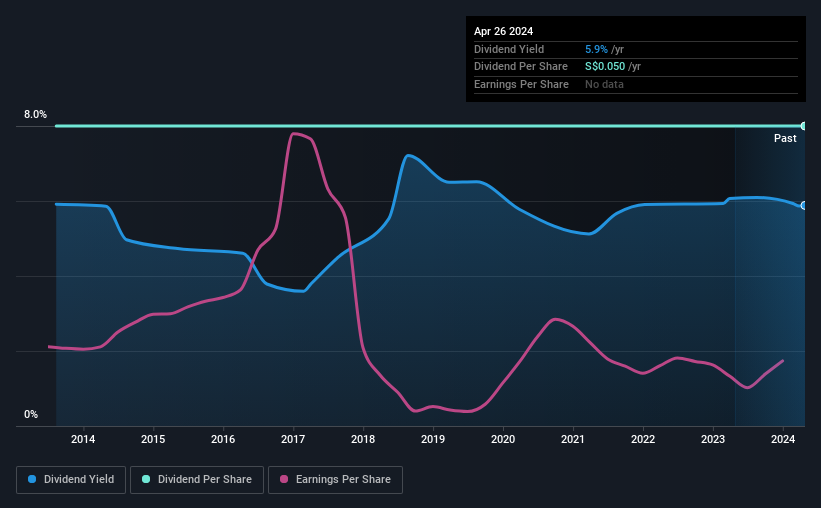Why It Might Not Make Sense To Buy QAF Limited (SGX:Q01) For Its Upcoming Dividend
Some investors rely on dividends for growing their wealth, and if you're one of those dividend sleuths, you might be intrigued to know that QAF Limited (SGX:Q01) is about to go ex-dividend in just 4 days. Typically, the ex-dividend date is one business day before the record date which is the date on which a company determines the shareholders eligible to receive a dividend. The ex-dividend date is of consequence because whenever a stock is bought or sold, the trade takes at least two business day to settle. Thus, you can purchase QAF's shares before the 2nd of May in order to receive the dividend, which the company will pay on the 23rd of May.
The company's upcoming dividend is S$0.04 a share, following on from the last 12 months, when the company distributed a total of S$0.05 per share to shareholders. Last year's total dividend payments show that QAF has a trailing yield of 5.9% on the current share price of S$0.85. Dividends are an important source of income to many shareholders, but the health of the business is crucial to maintaining those dividends. We need to see whether the dividend is covered by earnings and if it's growing.
View our latest analysis for QAF
Dividends are typically paid from company earnings. If a company pays more in dividends than it earned in profit, then the dividend could be unsustainable. Last year, QAF paid out 105% of its income as dividends, which is above a level that we're comfortable with, especially if the company needs to reinvest in its business. Yet cash flows are even more important than profits for assessing a dividend, so we need to see if the company generated enough cash to pay its distribution. Over the past year it paid out 161% of its free cash flow as dividends, which is uncomfortably high. It's hard to consistently pay out more cash than you generate without either borrowing or using company cash, so we'd wonder how the company justifies this payout level.
QAF does have a large net cash position on the balance sheet, which could fund large dividends for a time, if the company so chose. Still, smart investors know that it is better to assess dividends relative to the cash and profit generated by the business. Paying dividends out of cash on the balance sheet is not long-term sustainable.
Cash is slightly more important than profit from a dividend perspective, but given QAF's payments were not well covered by either earnings or cash flow, we are concerned about the sustainability of this dividend.
Click here to see how much of its profit QAF paid out over the last 12 months.

Have Earnings And Dividends Been Growing?
Stocks in companies that generate sustainable earnings growth often make the best dividend prospects, as it is easier to lift the dividend when earnings are rising. Investors love dividends, so if earnings fall and the dividend is reduced, expect a stock to be sold off heavily at the same time. It's encouraging to see QAF has grown its earnings rapidly, up 27% a year for the past five years. Earnings per share are increasing at a rapid rate, but the company is paying out more than we are comfortable with, based on current earnings. Generally, when a company is growing this quickly and paying out all of its earnings as dividends, it can suggest either that the company is borrowing heavily to fund its growth, or that earnings growth is likely to slow due to lack of reinvestment.
The main way most investors will assess a company's dividend prospects is by checking the historical rate of dividend growth. QAF's dividend payments are effectively flat on where they were 10 years ago.
Final Takeaway
Has QAF got what it takes to maintain its dividend payments? Earnings per share have been growing, despite the company paying out a concerningly high percentage of its earnings and cashflow. We struggle to see how a company paying out so much of its earnings and cash flow will be able to sustain its dividend in a downturn, or reinvest enough into its business to continue growing earnings without borrowing heavily. It's not that we think QAF is a bad company, but these characteristics don't generally lead to outstanding dividend performance.
With that being said, if you're still considering QAF as an investment, you'll find it beneficial to know what risks this stock is facing. For example, we've found 2 warning signs for QAF (1 shouldn't be ignored!) that deserve your attention before investing in the shares.
If you're in the market for strong dividend payers, we recommend checking our selection of top dividend stocks.
Valuation is complex, but we're here to simplify it.
Discover if QAF might be undervalued or overvalued with our detailed analysis, featuring fair value estimates, potential risks, dividends, insider trades, and its financial condition.
Access Free AnalysisHave feedback on this article? Concerned about the content? Get in touch with us directly. Alternatively, email editorial-team (at) simplywallst.com.
This article by Simply Wall St is general in nature. We provide commentary based on historical data and analyst forecasts only using an unbiased methodology and our articles are not intended to be financial advice. It does not constitute a recommendation to buy or sell any stock, and does not take account of your objectives, or your financial situation. We aim to bring you long-term focused analysis driven by fundamental data. Note that our analysis may not factor in the latest price-sensitive company announcements or qualitative material. Simply Wall St has no position in any stocks mentioned.
About SGX:Q01
QAF
An investment holding company, engages in the manufacture and distribution of bread, bakery, and confectionery products in Singapore, Australia, the Philippines, Malaysia, and internationally.
Flawless balance sheet average dividend payer.
Market Insights
Community Narratives



